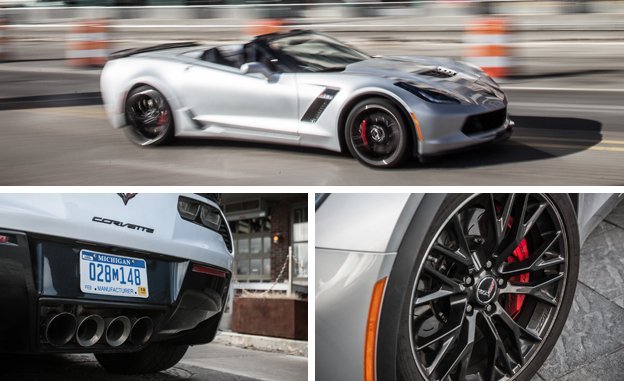Today, with GM back on track, the Corvette Z06 has resumed its traditional role of import-ass-kicker. An Eaton supercharger and two heat exchangers crammed into the intake manifold force-feed a 6.2-liter small-block with up to 9.4 psi of chilled air, yielding 650 horsepower. That’s the largest herd of ponies GM has ever wrangled into any production car. Ignoring the industry switch from gross to net ratings in the 1970s, that’s a 49-percent increase in peak power since 1967. Factor in the safety advancements, emissions controls, and creature comforts added through the years, and the result is a curb weight up by nearly 500 pounds. But there’s also a nearly threefold increase in rear tire width—from the 1967’s 7.75-15 Firestone bias-plies to today’s P335/25ZR-20 Michelin Pilot Super Sport ZP radials, on wheels exactly twice as wide.
Both Corvettes excel at embossing rubber onto pavement. The rowdy ’67 lights them up with every first-gear full-throttle indulgence, leaving two skinny squiggles for a signature. Suspension and differential advancements enable the Z06 to securely hold its assigned launch path, so its asphalt scars are deeper, wider, straighter, and longer. That said, it takes a brave soul to hold the throttle down with stability aids disabled on wet pavement.
|
|
In 1967, the Corvette 427 was one of the quickest production cars C/D had ever tested, topped only by Shelby Cobras. With two aboard (a passenger was needed to click the stopwatches back then), one coupe clocked 4.7 seconds to 60 mph and 13.6 seconds at 105 mph in the quarter-mile. That quarter run is more than two seconds and 22 mph slower than the Z06 tested here. So, after the new Corvette humbles its forebear during a few playful stoplight sprints, our battle of the decades switches to ceremonial hot laps between Detroit and Pontiac.
Michigan Highway 1, or Woodward Avenue, vectors northwest out of the city and into suburbia, forming part of the old pre-interstate link to Pontiac, Flint, and Saginaw, other Michigan towns important to GM history. A mecca for muscle-car enthusiasts, the street hosts 30,000 cars and more than a million spectators for the annual Woodward Dream Cruise held on the third Saturday in August, when the avenue becomes a 16-mile-long parking lot jammed with overheated muscle machines, twitching street rods, and minivan-borne gawkers.
|
|
In the 1960s, Henry Ford’s massive Model T plant on Woodward in Highland Park still produced military vehicles. Chrysler HQ sat a few blocks away, and the Mopar skunkworks was housed in a former Pontiac dealership. Cars created by day at Chrysler’s Woodward garage defended Mopar’s street-racing honor by night in the hands of skilled operatives. One hallowed survivor of the era is a ’67 Plymouth Belvedere GTX known as the Silver Bullet. Bob Seger’s band is said to be named after it. The Bullet boasted a curb weight trimmed by 500 pounds and an 8.0-liter Hemi fed by two four-barrels delivering an easy 650 horsepower through the mufflers. Rolling on drag slicks, it still runs the quarter in the low 10s at 132 mph. Imagine pulling up in your Chevelle SS396 and watching this stock-looking GTX loft its front tires when the light turns green.
|
|
Downtown Detroit was an entertainment capital offering 24-hour bowling alleys, hundreds of gin joints, and some of America’s most ornate performing-arts theaters. In Midtown Detroit, on Grand Boulevard near Woodward, sat GM’s Albert Kahn–designed headquarters. On the top, two sets of 13-foot neon letters beamed GENERAL MOTORS across the land. But in the wee hours of July 23, 1967, Detroit changed forever. A police raid on a blind pig that was just over a mile from GM’s offices triggered a riot resulting in 43 deaths, 1189 injuries, 7200 arrests, and the destruction of 2000 buildings. It was the third race riot in the city’s history and by far its worst. Restoring order required city, county, and state police, National Guard tanks, and paratroopers from the 82nd Airborne.
In 1994, Coleman Young, Detroit’s first African-American mayor, summed up the destruction of his city once known as the Paris of the West: “Detroit’s losses went a hell of a lot deeper than the immediate toll of lives and buildings. The riot put Detroit on the fast track to economic desolation, mugging the city and making off with incalculable value in jobs, earnings taxes, corporate taxes, retail dollars, sales taxes, mortgages, interest, property taxes, development dollars, investment dollars, tourism dollars, and plain damn money. The money was carried out in the pockets of the businesses and the white people who fled as fast as they could. The white exodus from Detroit had been prodigiously steady prior to the riot, totaling 22,000 in 1966, but afterwards it was frantic.”
View Photos
View Photos


Leave a Reply